Learning to CODE Will Make You a Better Storyteller
The woman who discovered the danger of trying not to yawn

The Story
I could see from the violent twitching in her face that she was trying to suppress her yawn.
The young woman I was sharing with in the virtual breakout room of the conference was doing her best to conceal it, but there was no mistaking her stifled impulse to parade her tonsils.
She unsuccessfully tried to cover it by scratching her nose. Still, I could see her nostrils flaring like a charging rhino, her eyes reflexively narrow and water, and her jaw flex as she tried to swallow that mouthful of boredom instead of letting it show.
But it did. Big time.
I was trying to be warm and engaging as I shared my personal story, but at twice her age I was apparently nowhere on the radar of her interest. My self-confidence shrank as I watched this fountain of feminine youth fight back her desire to just open her mouth and inhale the full relief of a satisfying yawn. I searched for a reason to sign off and leave her in peace, perched in her cozy office with that lime-green fern gracing her shoulders and her designer coffee mug steaming in one hand.
In the midst of my private lament, however, the tables of embarrassment were about to instantly turn—and neither of us saw it coming.
As she was busy trying to manage her erupting facial contortions, her attention fully occupied on suppression above the neck, she failed to stop a form of expression that came from below her waist.
It was audible enough that I could hear it on her microphone.
I can tell you that right then and there she stopped being bored. She turned bright red, and now I was suppressing my own physiological impulse, explosive laughter, and carried on with my story as though I hadn’t heard her let one rip.
I gained some leverage in this unusual circumstance and had her attention for the rest of our fifteen minutes together.
The Lesson
If I wanted to capture the attention of a much younger person, or anyone in future who sees me as being different from them and perhaps irrelevant, I needed to be a better storyteller.
So, I started to study it.
Particularly, I was interested in what the human brain does in response to a story. After learning about the neuroscience behind it, I began experimenting in my own writing by sharing personal life experiences and exercising fundamental storytelling principles. Taking inventory of those experiences and learning how to best share them has been the foundation of a lucrative career as a speaker. Stories are a primary resource for anyone who needs to communicate in the course of their professional duties. They’re a bonafide asset for leaders, authors, teachers, coaches, founders, counselors, therapists, trainers, and even parents. When you learn to draw stories from your own personal life experience, you have an endless supply of unique and authentic invitations for human connection.
No matter your age, race, gender, or status—if you want better relationships with anyone, you’ll need to become storyfluent. The human brain uses the language of story as its operating system. Master the operating system and you’ve mastered communication.
The OS I’m talking about runs on the neurotransmitters firing in our gray matter. That’s why learning to CODE in the language of storytelling might be the most important 21st century skill you’ll ever learn.
Storytelling CODE gives you a way to assess if you actually have a story to tell, a way to tease a hidden story out of the shadows if you’re not sure what the story is, and a way to pique your own interest in what you’re saying so that others will naturally engage.
The CODE Breakdown
Here’s what the CODE of storytelling stands for:
Cortisol
Oxytocin
Dopamine
Endorphins
The goal is to activate these neurotransmitters in your listener, because each of them impact the listener’s attention and perception in critical ways.
The method you’ll use to activate these chemical agents is also a CODE acronym.
Create tension
Open their heart
Delight their senses
Engage them with novelty and surprise
By following these four steps in your storytelling you’ll activate each of the neurotransmitters, and they all help in a unique way to engage your reader.
Let’s do a quick review of the above story and what happens in a human being when these neurological messengers are active in the system.
The presence of cortisol in the bloodstream makes us sit up straight and pay attention. It’s activated when we perceive tension or conflict, and then helps us to feel alert and engaged. As a storyteller, it’s how we first capture attention.
“I could see from the violent twitching in her face that she was trying to suppress her yawn.”
Oxytocin is secreted when we empathize with the experience of another person. It creates feelings of connection, compassion, and understanding. These are potent emotions that draw the listener in.
“I’d been doing my best to convey my enthusiasm for my subject, but at twice her age I was apparently irrelevant, boring and ignorable.”
Dopamine makes us feel really good is when our senses are being rewarded. It makes us feel accomplished, on the right track, fulfilled, and enriched when we’re moving toward abundance.
“I wanted to sign off and leave her in peace, perched in her cozy office with that lime-green fern gracing her shoulders and her designer coffee mug steaming in one hand.”
Endorphins are the ah-hah juices that make us feel delighted, elated, enlightened, and entertained by the emerging secrets and surprises of life.
“As she was busy trying to manage her involuntary facial gymnastics, her attention fully occupied on suppression above the neck, she failed to stop a form of expression that came from below her waist.”
I’ve shared the key parts of my introductory story and the elements I’ve intentionally used to create a scene and narrative that is hard to turn away from.
These charged particles of story are what hold the attention of a listener or reader and give the author tremendous leverage to inspire, educate, and connect with their audience.
The Cheat Code
The quickest and simplest way to access this CODE in your storytelling is to touch on these four elements as you share—the 4 Ps.
Problem
People
Place
Perspective
The larger associated picture of how CODE engages an audience can be seen in this infographic.
Fortunately, there’s no need to remember all of these associative connections to activate them for your audience.
Just focus on the 4 P’s—problem, people, place, and perspective—and the engagement will naturally follow.
One More Example
By way of another example I invite you to watch this short (hilarious) video on yawn suppression.
As you watch, notice all four stages of story CODE being used to keep you riveted.
Creating tension with social awkwardness
Opening the heart with empathy
Delighting the senses the cinematography and location
Engaging with novelty and surprise at the end
Laughter, by the way, is a standalone source of neuro-transformational magic.
If you can evoke it in your audience in the right way and at the right time, you imbue your storytelling with superpowers.
I hope this was useful for your own storytelling craft.
If not, and this bored the heck out of you, please feel free to open wide and loudly sigh out the most satisfying of yawns rather than suppress your urge.
We wouldn’t want your truth to be communicated in a less forward manner.



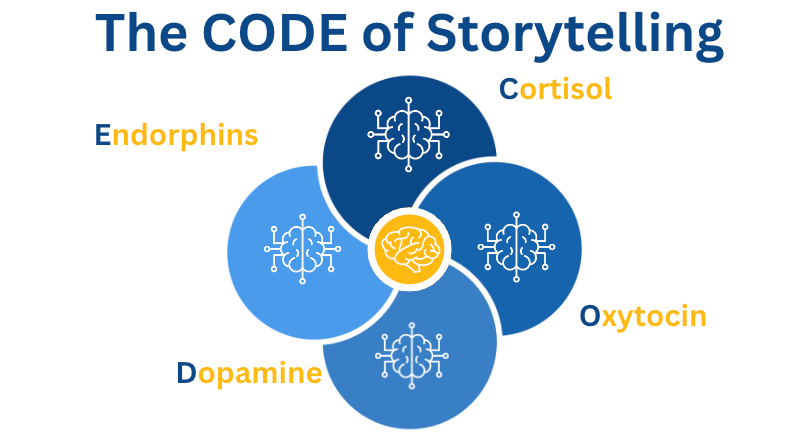
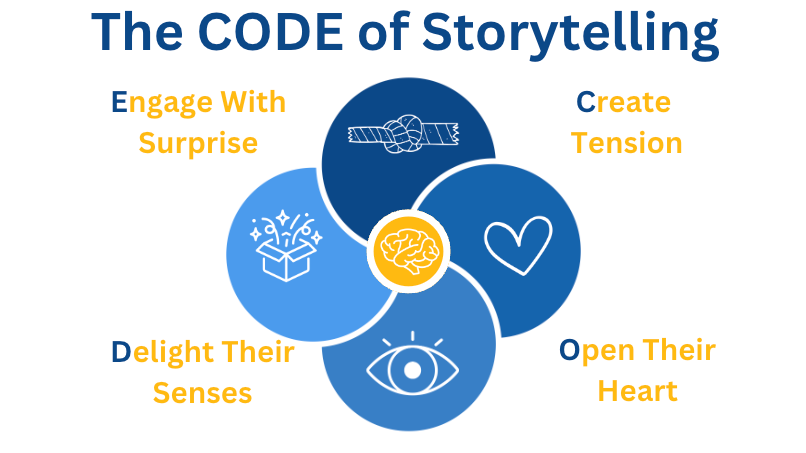
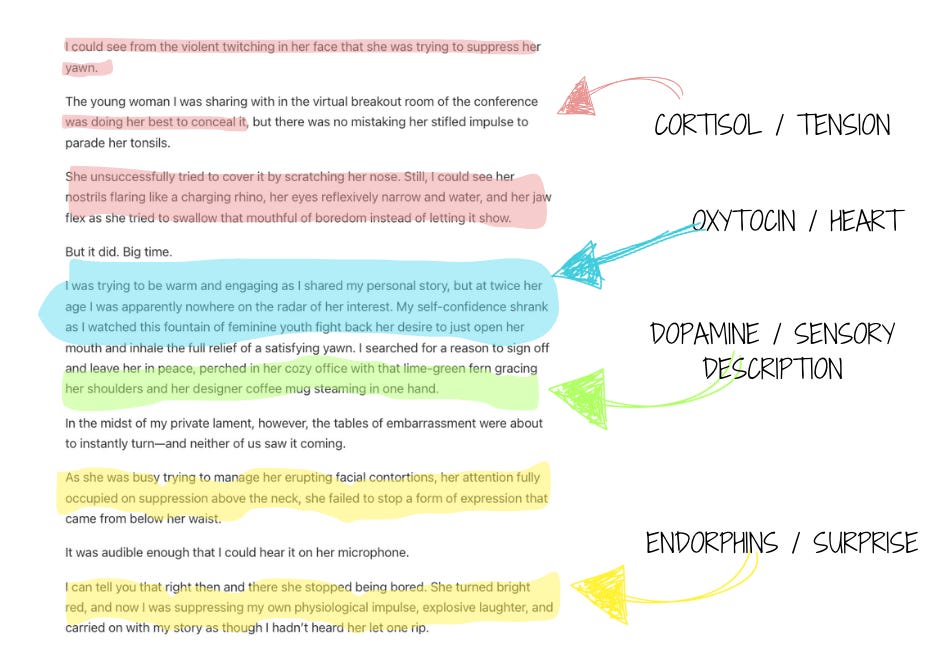
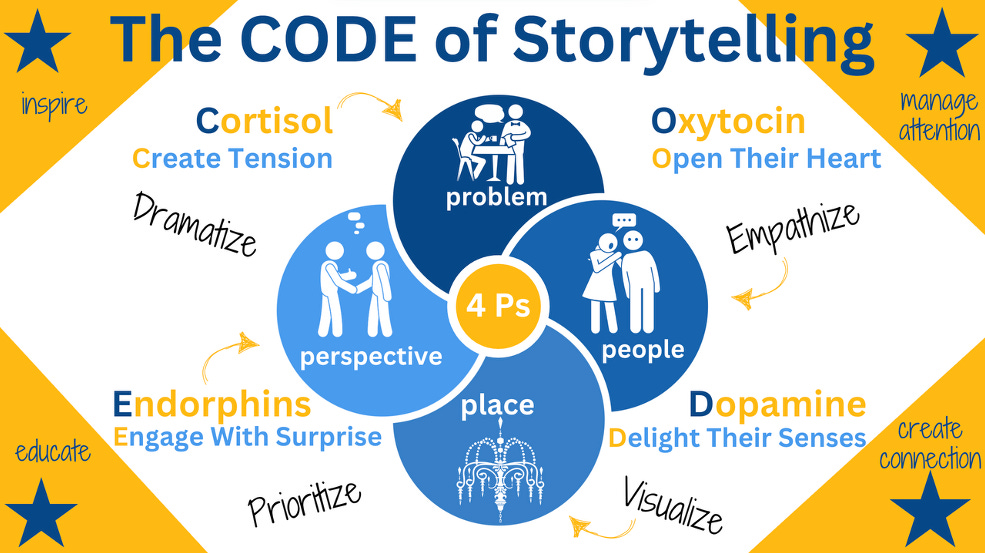
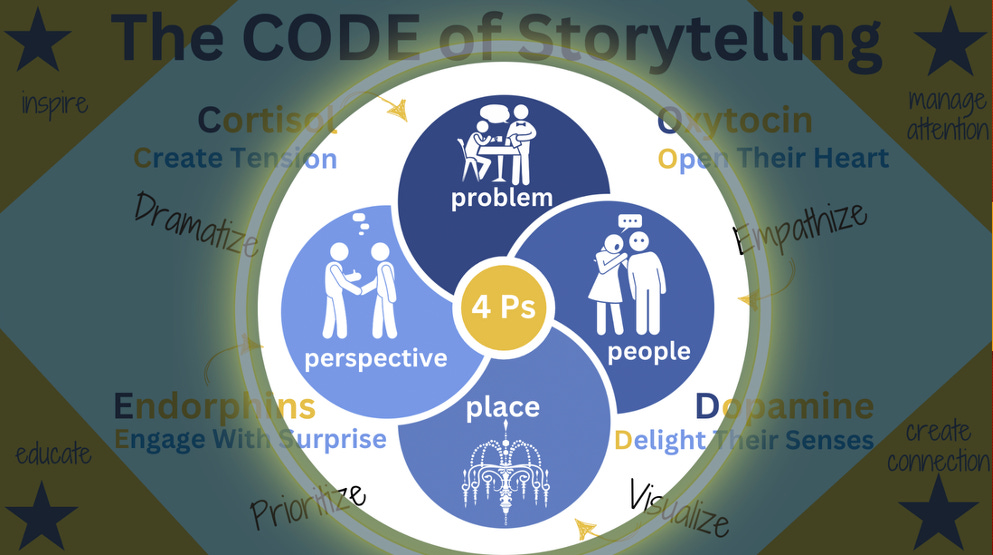
I don’t know how I have missed you before now, but so glad I found you. Brilliant article - so practical and helpful.
I'm stealing this for myself - thank you Rick!!
I really thought you were going to explain how python programming will help me tell better stories haha
One question: do storytelling principles translate 1:1 between written and spoken? When telling stories to others its not natural/simple to think about "okay this will be the tension" while sharing among a group of friends.
Asking because while I think i've gotten better at writing stories, telling stories is a different game